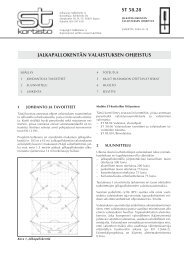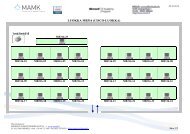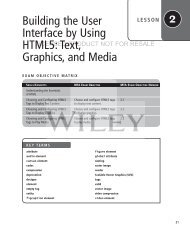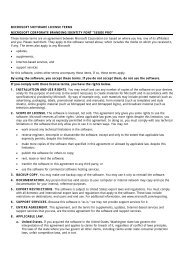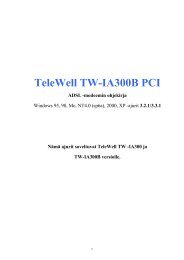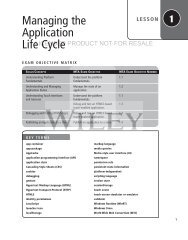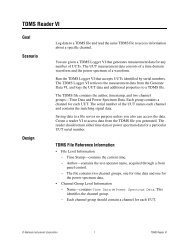Building the User Interface by Using HTML5: Organization ... - server
Building the User Interface by Using HTML5: Organization ... - server
Building the User Interface by Using HTML5: Organization ... - server
You also want an ePaper? Increase the reach of your titles
YUMPU automatically turns print PDFs into web optimized ePapers that Google loves.
<strong>Building</strong> <strong>the</strong> <strong>User</strong> <strong>Interface</strong> <strong>by</strong> <strong>Using</strong> <strong>HTML5</strong>: <strong>Organization</strong>, Input, and Validation | 73<br />
• To capture user comments after an article on a Web site<br />
• To select preferences on a Web page<br />
• To enter reservation information<br />
Many client applications use some kind of Web form to interact with <strong>the</strong> user.<br />
You use HTML input elements to build a form’s interface and ensure that information is collected<br />
from users consistently. Validation ensures that <strong>the</strong> entered information is in <strong>the</strong> correct format<br />
and usable before sending <strong>the</strong> data to <strong>the</strong> <strong>server</strong>. For example, if you enter “637 Park Street” into<br />
a Web address field, which is expecting something like “http://www.example.com”, validation will<br />
fail and prompt <strong>the</strong> user to correct <strong>the</strong> input. Validation also reduces <strong>the</strong> amount of spam and<br />
malicious content that can make its way to <strong>the</strong> <strong>server</strong> or <strong>the</strong> recipient of <strong>the</strong> form’s data.<br />
LICENSED PRODUCT NOT FOR RESALE<br />
Understanding Input and Forms<br />
TAKE NOTE<br />
*<br />
Check <strong>the</strong> functionality<br />
of any form you create<br />
in many different browsers<br />
during development.<br />
This ensures <strong>the</strong> elements<br />
and attributes you<br />
select work as expected<br />
or <strong>the</strong> fall-back<br />
method collects acceptable<br />
input.<br />
Table 3-4<br />
Form element attributes used<br />
in <strong>HTML5</strong><br />
Most Web forms, or at least many fields in most forms, require specifically formatted<br />
input. The new <strong>HTML5</strong> form and input attributes are intuitive, easy to use, and replace<br />
a lot of scripting that was required in HTML 4.01 and previous versions.<br />
Form input is <strong>the</strong> information a user enters into fields in a Web or client application form.<br />
(To keep things simple, we use <strong>the</strong> term “Web form” most of <strong>the</strong> time, but it applies to client<br />
application as well.) <strong>HTML5</strong> introduces several new form and input element attributes, such<br />
as url for entering a single Web address, email for a single email address or a list of email<br />
addresses, and search to prompt users to enter text <strong>the</strong>y want to search for. The new attributes<br />
make form development much easier than in <strong>the</strong> past. What used to take a lot of scripting<br />
can be accomplished <strong>by</strong> <strong>HTML5</strong> tags.<br />
On <strong>the</strong> flip side, many of <strong>the</strong> new attributes are not yet supported <strong>by</strong> all of <strong>the</strong> major browsers.<br />
However, if you use a new element or attribute that isn’t yet supported, <strong>the</strong> browser “falls<br />
back” to an alternate display, a different form of input, or what have you.<br />
<strong>HTML5</strong> introduces two new attributes for <strong>the</strong> form element—autocomplete and novalidate.<br />
All attributes for <strong>the</strong> form element are listed in Table 3-4, with <strong>the</strong> new attributes indicated<br />
with a double asterisk.<br />
ATTRIBUTE VALUE DESCRIPTION<br />
accept-charset character_set Specifies a set of character encodings <strong>the</strong><br />
<strong>server</strong> accepts<br />
action URL Specifies <strong>the</strong> Web address to which form<br />
data is sent<br />
autocomplete** on Specifies whe<strong>the</strong>r autocomplete is on or off<br />
off<br />
in a form or input field; can be “on” for<br />
specific input fields and “off” for <strong>the</strong> form,<br />
or vice versa<br />
enctype application/x-www- Specifies <strong>the</strong> encoding type for form data<br />
form-urlencoded when submitting <strong>the</strong> data to a <strong>server</strong>;<br />
multipart/<br />
used only for method="post"<br />
form-data<br />
text/plain<br />
(continued)



